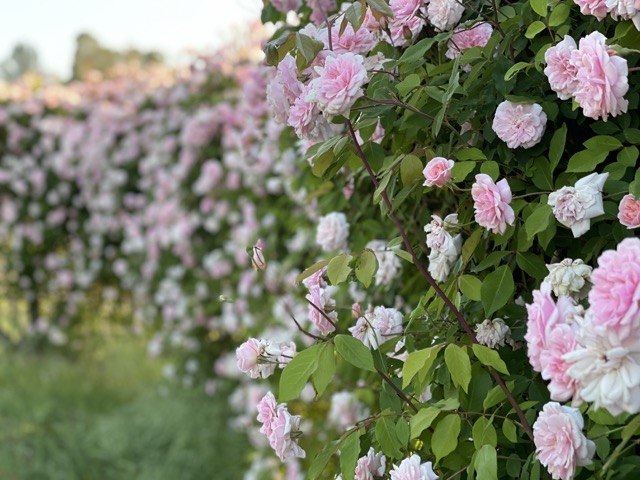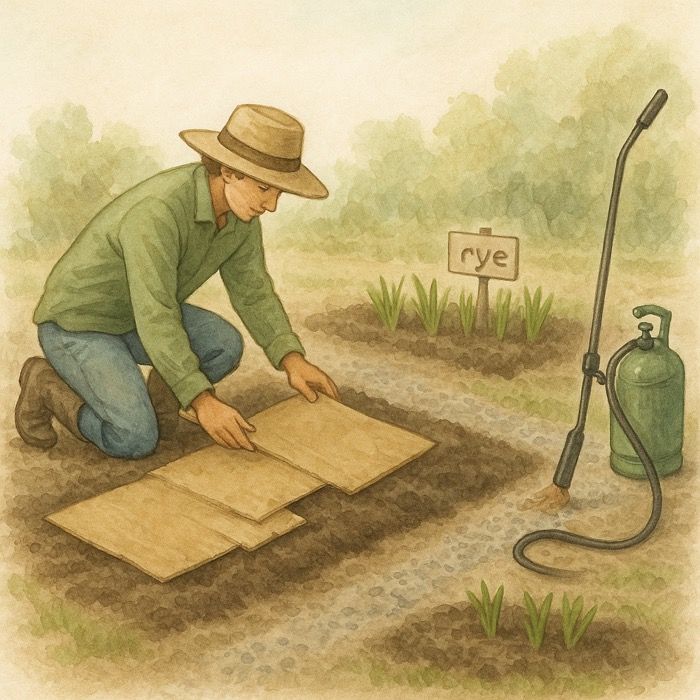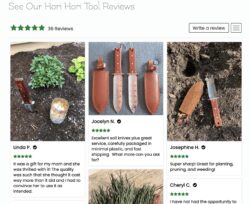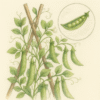How Do I Prune a Rose Bush: A Comprehensive Guide
Table of Contents
- Introduction to Rose Bush Pruning
- Importance of Pruning
- Tools Needed
- Timing for Pruning
- Basic Pruning Techniques
- Deadheading
- Thinning
- Rejuvenation Pruning
- Pruning Different Types of Roses
- Hybrid Tea Roses
- Floribunda Roses
- Grandiflora Roses
- Shrub Roses
- Climbing Roses
- Aftercare and Maintenance
- Fertilizing
- Watering
- Pest and Disease Control
- Troubleshooting Common Pruning Problems
- Weak or Damaged Branches
- Lack of Blooms
- Excessive Growth
- Additional Tips and Tricks
- Pruning for Specific Goals
- Rose Bush Training
- Winter Protection
- Conclusion
- Recap of Key Points
- Encourage Further Learning
- References
Introduction to Rose Bush Pruning
Roses are a true passion, and require constant attention for optimal blooms and growth. And pruning is a critical aspect of rose bush care that significantly influences the health, shape, and flowering potential of the plant. Whether you’re a gardening enthusiast or a professional landscaper, mastering rose bush pruning can enhance the beauty and productivity of your garden. This guide will provide a step-by-step approach to pruning, covering everything from the best tools to use to specific techniques for different types of roses.
Importance of Pruning
Pruning is a fundamental horticultural practice that involves selectively removing parts of a plant, such as branches, buds, or roots, to improve its health, growth, and appearance. PLANT NERD ALERT!! – the following paragraph may cause a headache for those that want to avoid plant biology. Biologically, pruning stimulates the plant’s natural response mechanisms, such as the production of growth hormones like auxins and cytokinins. These hormones regulate the growth direction, enhance bud development, and promote the formation of strong, healthy branches. Pruning also helps manage the plant’s energy distribution, directing nutrients and resources to the healthiest and most productive parts of the plant. This process can prevent disease by improving air circulation and reducing the risk of fungal infections on overcrowded branches. Furthermore, pruning encourages flowering and fruit production, as well-pruned plants can focus their resources on fewer but more vigorous shoots and blooms. Understanding the science behind pruning allows gardeners to enhance plant structure, optimize yields, and ensure long-term vitality of their garden.
Pruning is essential in roses and other plants, and I would highlight these in bullet form below:
- Encourages Healthy Growth – Pruning stimulates new growth, which is crucial for the plant’s vigor and bloom production. Removing dead or diseased wood helps prevent the spread of infections and pests.
- Improves Air Circulation – Proper pruning opens up the center of the plant, improving air circulation and reducing the likelihood of fungal diseases like black spot and powdery mildew.
- Enhances Flower Production – By removing old, non-productive wood and directing the plant’s energy toward new growth, pruning can result in more abundant and vibrant blooms.
- Shapes the Plant – Pruning allows you to control the size and shape of your rose bush, keeping it aesthetically pleasing and well-balanced within your garden design.
Tools Needed
The reason I founded Celtic Farm is that I got tired of having poor quality tools, and taking twice as long to do gardening tasks because I was missing a specific tool for the job. Having the right tools is essential for effective pruning. Here is a rose pruning kit:
- Bypass Pruners – These are ideal for making clean cuts on live wood up to half an inch in diameter. Choose a high-quality pair that is easy to handle and sharp enough to make precise cuts.
- Loppers – For larger branches, loppers are necessary. They have longer handles for increased leverage, making it easier to cut thicker stems.
- Pruning Saw – For very thick or old wood, a pruning saw is necessary. It allows for precise cutting without damaging the plant.
- Gloves – Protect your hands from thorns with a good pair of gardening gloves. Leather gloves provide the best protection.
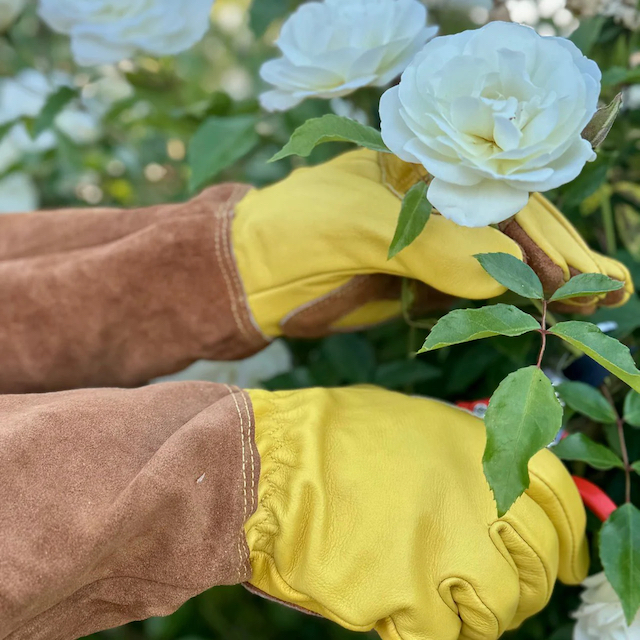
- Disinfectant – Use a disinfectant solution to clean your tools before and after pruning, especially if you’re working with diseased plants. This helps prevent the spread of pathogens. You can read more here: Disinfecting Pruning Tools
Timing for Pruning
The timing of rose bush pruning depends on your climate and the type of rose. Here are some general guidelines:
- Early Spring – This is the best time for most rose varieties. Prune just as new growth begins, when the buds start to swell but before they break open.
- After First Frost – In colder climates, wait until after the first frost to prune, as this allows the plant to enter dormancy and protects new growth from frost damage.
- Summer Pruning – Light pruning can be done in summer to remove dead or faded blooms (deadheading) and shape the plant. Avoid heavy pruning during this time as it can stress the plant.
Basic Pruning Techniques
Deadheading
Deadheading is the process of removing spent flowers to encourage the plant to produce more blooms. Here’s how to do it –
- Locate the First Set of Five Leaves – Cut the stem just above the first set of five leaves below the spent flower. This is where the next bloom will emerge.
- Angle the Cut – Make a 45-degree cut angled away from the bud, ensuring that water runs off and does not collect on the cut surface.
Master Gardener Tip: Cut to a Healthy, Outward-Facing Bud – When pruning your rose bush, always make your cuts just above a healthy, outward-facing bud. This technique encourages new growth to develop away from the center of the plant, promoting better air circulation and reducing the risk of disease. Additionally, it helps create a more open and aesthetically pleasing shape, which is particularly important for preventing overcrowding and ensuring that each branch receives adequate sunlight. Remember to make your cuts at a 45-degree angle to prevent water from collecting on the cut surface, which can lead to rot and other issues. This small detail can make a big difference in the health and beauty of your rose bush!
Master Gardener Steve
Thinning
Thinning involves removing some stems from the base to reduce overcrowding and improve air circulation. This technique is particularly important for preventing diseases in dense bushes –
- Remove Crossing Branches – Start by removing any branches that cross over or rub against each other. These can create wounds that invite pests and disease.
- Select Canes to Keep – Choose 4-6 healthy canes to keep, focusing on those that are strong, well-spaced, and facing outward.
Rejuvenation Pruning
Rejuvenation pruning is a more aggressive technique used to revitalize older plants that have become overgrown or leggy –
- Cut Back One-Third of the Oldest Canes – Remove about one-third of the oldest, woodiest canes at the base. This stimulates new growth and can reinvigorate a tired rose bush.
- Remove Dead Wood – Remove any dead or diseased wood, cutting back to healthy tissue. Make cuts at a 45-degree angle just above an outward-facing bud.
Pruning Different Types of Roses
Hybrid Tea Roses
Hybrid Tea Roses are known for their long stems and large, elegant blooms. To keep them at their best –
- Prune to an Open Vase Shape – Remove any canes that grow inward, aiming for an open center that allows sunlight and air to penetrate.
- Cut Back to 12-24 Inches – Prune each cane back to 12-24 inches above the ground, making cuts just above an outward-facing bud.
Floribunda Roses
Floribunda roses produce clusters of blooms and benefit from moderate pruning –
- Remove Dead and Weak Wood – Cut out any dead or weak canes. Then, reduce the height of the remaining canes by about one-third.
- Maintain a Bushy Shape – Aim for a well-rounded shape that allows light to reach the entire plant.
Grandiflora Roses
These roses combine the traits of Hybrid Tea and Floribunda roses, producing large flowers on long stems –
- Focus on Shaping and Health – Prune to remove any dead, diseased, or crossing branches. Then, shape the plant by cutting back to about 18-30 inches.
- Encourage New Growth – Cut just above an outward-facing bud to promote new growth in the desired direction.
Shrub Roses
Shrub roses are typically hardy and require minimal pruning –
- Remove Old Wood – Cut back about one-third of the oldest canes to the ground to encourage fresh growth.
- Shape Lightly – Trim the tips to maintain a natural, rounded shape.
Climbing Roses
Pruning climbing roses is different from bush roses and should be done after the first bloom cycle –
- Remove Spent Blooms – Deadhead after the first bloom cycle to promote additional flowering.
- Train and Secure Canes – Tie the main canes horizontally along a support structure. This encourages lateral growth and more blooms.
- Prune Lateral Canes – Cut lateral canes back to 3-4 buds from the main stem.
Aftercare and Maintenance
Fertilizing
After pruning, roses need nutrients to support their growth –
- Choose a Balanced Fertilizer – Use a balanced rose fertilizer with equal parts nitrogen, phosphorus, and potassium (e.g., 10-10-10).
- Apply at the Base – Spread the fertilizer evenly around the base of the plant, avoiding direct contact with the stems.
- Water Thoroughly – Water deeply to help the fertilizer penetrate the soil and reach the roots.
Watering
Proper watering is crucial for recovery after pruning –
- Water Deeply – Water deeply and consistently, ensuring the soil is moist but not waterlogged. This helps the plant recover and supports new growth.
- Avoid Wetting the Leaves – Water at the base of the plant to prevent fungal diseases. Mulch around the base can help retain moisture.
Pest and Disease Control
After pruning, monitor your rose bushes for signs of pests and disease –
- Common Pests – Aphids, spider mites, and thrips are common rose pests. Use insecticidal soap or neem oil as needed.
- Diseases – BlackPests like black spot, powdery mildew, and rust are common fungal diseases for roses. Here’s how to manage them –
- Black Spot – Identify black spots on leaves and remove affected foliage. Use a fungicidal spray to prevent further spread.
- Powdery Mildew – Appears as a white, powdery coating on leaves. Remove affected leaves and treat with a fungicide.
- Rust – Look for orange, rust-colored spots on the undersides of leaves. Remove affected foliage and use a sulfur-based fungicide.
Troubleshooting Common Pruning Problems
Weak or Damaged Branches
Weak or damaged branches can be a result of poor pruning practices or environmental stress. They can compromise the health and appearance of your rose bush –
- Identify Problematic Branches – Look for branches that appear thin, discolored, or have visible damage from pests or disease.
- Remove Carefully – Use sharp, sanitized pruners to cut back to healthy wood. Make clean cuts just above an outward-facing bud.
- Prevent Future Damage – Avoid heavy pruning during hot or freezing conditions, and ensure your rose bush receives adequate water and nutrients.
Lack of Blooms
If your rose bush is not producing enough blooms, it could be due to several factors, including improper pruning, insufficient sunlight, or nutrient deficiencies –
- Check Pruning Techniques – Make sure you are not over-pruning or cutting off too much new growth. For most roses, leave 3-4 healthy canes and avoid cutting them too short.
- Sunlight Requirements – Ensure your rose bush is getting at least 6-8 hours of direct sunlight daily. If it’s not, consider relocating the plant to a sunnier spot.
- Nutrient Deficiency – Apply a balanced fertilizer to provide essential nutrients. If growth is still sluggish, consider a soil test to check for deficiencies.
Excessive Growth
Excessive or leggy growth can make your rose bush look untidy and reduce flower production. This is often due to over-fertilization or insufficient pruning –
- Moderate Fertilization – Reduce the amount of nitrogen-rich fertilizer, as too much nitrogen promotes leafy growth at the expense of flowers.
- Control Growth with Pruning – Regularly prune back excessive growth to maintain a balanced shape. Remove suckers and any canes that grow inwards or cross over each other.
- Shape and Train – For climbing and rambling roses, regularly train the canes along a support structure to manage growth and encourage blooming.
Additional Tips and Tricks
Pruning for Specific Goals
Tailor your pruning techniques to achieve specific goals –
- For Larger Blooms – If you want fewer but larger flowers, focus on removing more buds and stems, allowing the plant to direct energy to fewer blooms.
- For a Bushier Plant – Prune lightly but more frequently, removing the tips of young growth to encourage more lateral branches.
Rose Bush Training
Training is essential for climbing and rambling roses. It helps control their shape and encourages abundant blooms –
- Horizontal Training – Secure canes horizontally along a trellis or fence. This encourages more flowering along the length of the cane.
- Support with Ties – Use soft garden ties to secure canes. Avoid tying too tightly to prevent damage as the cane grows.
Winter Protection
In colder climates, winter protection is crucial to prevent frost damage and ensure healthy growth in the spring –
- Mulching – Apply a thick layer of mulch around the base of the plant after the ground has frozen. This insulates the roots and prevents freeze-thaw cycles.
- Covering – For particularly cold regions, consider wrapping the rose bush in burlap or using rose cones to protect against harsh winds and frost.
Conclusion
Recap of Key Points
Pruning rose bushes is an essential task for maintaining their health, shape, and bloom production. Use the right tools, prune at the right time, and tailor your approach based on the type of rose bush. Remember to care for your roses after pruning with proper fertilization, watering, and pest control.
Encourage Further Learning
If you’re looking to deepen your knowledge of rose care, check out our other guides coming sooon on rose variety selection, disease prevention, and seasonal maintenance. Happy gardening!
References
American Rose Society – Pruning Roses
Royal Horticultural Society – How to Prune Roses
Gardening Know How – Rose Pruning Tips
UC Master Gardener Program – Rose Pruning Guide
Old Farmer’s Almanac – Rose Pruning Techniques
More From Our Master Gardener
Recent Posts

❄️ Snow as Fertilizer – The Truth About “Poor Man’s Nitrogen”

5 Unexpected Winter Weed Control Strategies (That Don’t Involve Mulch)

Harnessing Winter Sun – Passive Solar Tricks for Your Garden

How to Grow Spinach – The Ultimate Beginner’s Guide for Tender, Nutritious Leaves

How to Grow Peas: The Ultimate Beginner’s Guide for Sweet, Crisp Harvests

